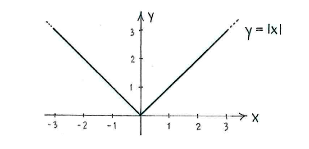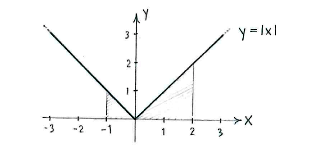Lösung 2.1:1d
Aus Online Mathematik Brückenkurs 2
K (Lösning 2.1:1d moved to Solution 2.1:1d: Robot: moved page) |
|||
| Zeile 1: | Zeile 1: | ||
| - | + | The modulus function, | |
| - | < | + | <math>\left| x \right|</math>, strips |
| - | + | <math>x</math> | |
| - | + | of its sign, e.g. | |
| - | < | + | |
| - | + | ||
| + | <math>\left| -5 \right|=5</math>, | ||
| + | <math>\left| 3 \right|=3</math> | ||
| + | and | ||
| + | <math>\left| -\pi \right|=\pi </math> | ||
| + | |||
| + | |||
| + | For positive values of | ||
| + | <math>x</math>, the modulus function has no effect, since | ||
| + | <math>\left| x \right|=x</math>, but for negative | ||
| + | <math>x</math> | ||
| + | the modulus function changes the sign of | ||
| + | <math>x</math>, i.e. | ||
| + | <math>\left| -x \right|=x</math> | ||
| + | (remember that | ||
| + | <math>x</math> | ||
| + | is negative and therefore | ||
| + | <math>-x</math> | ||
| + | is positive). | ||
| + | |||
| + | If we draw a graph of | ||
| + | <math>y=\left| x \right|</math> | ||
| + | it will consist of two parts. For | ||
| + | <math>x\ge 0</math> | ||
| + | we have | ||
| + | <math>y=x</math>, and for | ||
| + | <math>x\le 0</math> | ||
| + | we have | ||
| + | <math>y=-x</math> | ||
| + | |||
| + | |||
| + | |||
[[Image:2_1_1_d1.gif|center]] | [[Image:2_1_1_d1.gif|center]] | ||
| + | |||
| + | |||
| + | The value of the integral is the area of the region under the graph | ||
| + | <math>y=\left| x \right|</math> | ||
| + | and between | ||
| + | <math>x=-1</math> | ||
| + | and | ||
| + | <math>x=2</math>. | ||
| + | |||
| + | |||
[[Image:2_1_1_d2.gif|center]] | [[Image:2_1_1_d2.gif|center]] | ||
| + | |||
| + | |||
| + | This region consists of two triangles and we therefore obtain | ||
| + | |||
| + | <math>\int\limits_{-1}^{2}{\left| x \right|}\,dx=\frac{1}{2}\centerdot 1\centerdot 1+\frac{1}{2}\centerdot 2\centerdot 2=\frac{5}{2}</math> | ||
Version vom 12:24, 17. Okt. 2008
The modulus function, \displaystyle \left| x \right|, strips \displaystyle x of its sign, e.g.
\displaystyle \left| -5 \right|=5,
\displaystyle \left| 3 \right|=3
and
\displaystyle \left| -\pi \right|=\pi
For positive values of
\displaystyle x, the modulus function has no effect, since
\displaystyle \left| x \right|=x, but for negative
\displaystyle x
the modulus function changes the sign of
\displaystyle x, i.e.
\displaystyle \left| -x \right|=x
(remember that
\displaystyle x
is negative and therefore
\displaystyle -x
is positive).
If we draw a graph of \displaystyle y=\left| x \right| it will consist of two parts. For \displaystyle x\ge 0 we have \displaystyle y=x, and for \displaystyle x\le 0 we have \displaystyle y=-x
The value of the integral is the area of the region under the graph
\displaystyle y=\left| x \right|
and between
\displaystyle x=-1
and
\displaystyle x=2.
This region consists of two triangles and we therefore obtain
\displaystyle \int\limits_{-1}^{2}{\left| x \right|}\,dx=\frac{1}{2}\centerdot 1\centerdot 1+\frac{1}{2}\centerdot 2\centerdot 2=\frac{5}{2}


